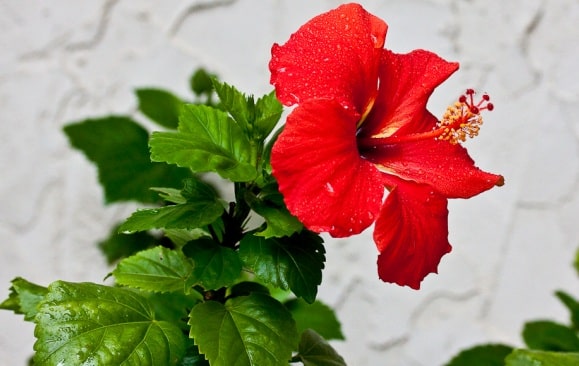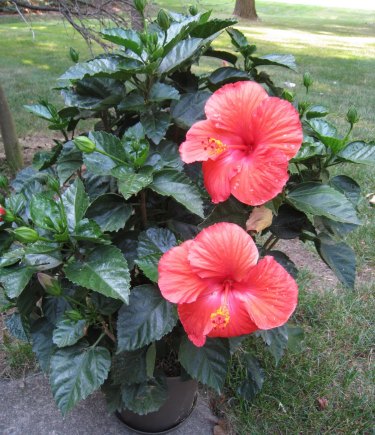Hibiscus Cultivation Guide:

Introduction of Hibiscus Cultivation:- Hibiscus is a genus of flowering plants in the mallow family, Malvaceae and one of the beautiful flower plants that can reach up to 15 feet height and 6 feet wide. The flowers of hibiscus plant up to 6″ in diameter and occur in many colors. This plant has medium-sized glossy green leaves with large flowers of a tropical appearance. Hibiscus flower colours range from yellow to peach to red. There are many improved varieties of hibiscus available in multi-colours. These flower plants can be grown in pots, containers, open fields even in greenhouse and polyhouse. For proper growth and quality of flowers, it requires constant moisture presence. Hibiscus flowers can be grown in all seasons where abundant water and sun shine is available. The scientific name of the hibiscus is “rosa-sinensis” meaning “Chinese Rose”.. Hibiscus has good uses and benefits. The tea made out of hibiscus flowers is very famous throughout the world. Hibiscus is also used in herbal medicines and cosmetics. With proper plant care, management and good marketing strategies, it can be a profitable commercial cultivation. Most of the people in India grow these flowers in pots or containers for decorative purpose.
Hibiscus Varieties:- There are many improved hybrid varieties of hibiscus are available with different colours. Contact your local nurseries for suitable varieties for the particular region.

Common Names of Hibiscus:- China Rose, Chinese hibiscus.
Local Names of Hibiscus in India:- Gurhal / Japapushp ( Hindi), Juba kusum athonba (Manipuri), Mandara (Telugu), Dasavala (Kannada), Cmbarutti (Tamil)Chemparati (Malayalam), Jaswand (Marathi), Dosni Phool (Konkani), ৰক্তজবা (Assamese), Joba (Bengali), Jasud (Gujarati), Mandara (Oriya).
Hibiscus Uses and Benefits:- The extract from hibiscus flowers and leaves have many uses and benefits.
- Hibiscus fights cancer.
- Hibiscus cures cold.
- Hibiscus slows ageing due anti-ageing properties.
- Hibiscus calms down hot flashes
- Hibiscus boosts energy.
- Hibiscus cures acne on the body.
- Hibiscus maintains fluid balance in the body.
- Hibiscus boosts body immunity.
- Hibiscus speeds up metabolism.
- Hibiscus prevents hair fall
- Hibiscus lowers the cholesterol level.
- Hibiscus darkens hair colour.
- Hibiscus is helpful in treating dandruff, hemorrhoids and blood pressure irregularities.
Climate Required for Hibiscus Cultivation:- Hibiscus requires 4-8 months with nighttime temperatures not below 20°C. In addition, it requires 12-13 hours of sunlight during the first 5 months of growth to prevent premature flowering. Hibiscus plants require a monthly rainfall ranging from 5″- 10″ during the first 4 months of growth.
Soil Requirement for Hibiscus Cultivation:- Hibiscus plants prefers sandy loam but not heavy soils. Growers can get many flowers with soil rich in organic matter. If these plants are grown in pots or containers, regular quality potting soil with added garden compost is an ideal base. To make this, composed cow manure, compost bark, and coarse peat should be mixed. Make sure the soil has well-drainage as these plants cannot tolerate water logging conditions. Make sure to have the soil in coarse stage rather than fine tilt. Hibiscus prefers neutral to slightly acidic soil. These plants thrive best in the soils with pH level between 5.5 and 6.5. If this crop is taken up as commercial on large scale, it is advised to go for soil testing. Any micro-nutrient deficiencies should be filled based on the test results.

Season for Hibiscus Cultivation:- Hibiscus can be grown throughout the year provided there is a sufficient irrigation and sun light.
Propagation, Seed Treatment and Planting in Hibiscus Cultivation:- Usually, hibiscus is propagated through both cuttings and seeds. Take a sprig of 5-6 inches length from immature branch leaving only a pair of leaves on the top. For proper formation of roots, wet the bottom end of the cutting with liquid fertilizer. This soft wood can be planted in pots or containers having well-drained soil. After covering the container / pot having cutting with plastic bag and place in a partial shaded area as direct sunlight can dry out the cuttings. It takes 8 to 10 weeks for cuttings to get roots. In case of seed propagation, make small nick in seeds using utility knives and soak the seeds in water overnight and then plant into the prepared pot or container. When buying hibiscus in nurseries, select disease free plants that have lots of new buds and healthy leaves.
Irrigation in Hibiscus Cultivation:- As Hibiscus plants are tropical, they prefer constant moisture and sunlight for good blooming. Irrigating / watering depend on the soil type and season. In case of hot and dry seasons, it requires daily watering. When the top leaves turning to yellow and started dropping indicates that the plant is not getting enough water. In rainy season, make sure there won’t be any water stagnating as it causes the root rot.
Manures and Fertilizers in Hibiscus Cultivation:- Hibiscus plant needs lots of nutrients for good blooming. In the summer time, use a high potassium fertilizer. You can either use a diluted liquid fertilizer once a week, a slow release fertilizer once a month or you can add high potassium compost to the soil. Supplementing the soil with garden compost or applying low phosphorous based fertilizer will result in high blooming. In winter, there is no need of fertilizing the plants.
Pruning in Hibiscus Cultivation:- August to October is the best time for pruning hibiscus plants. Pruning should be carried out to stimulate or encourage the new growth of shoots and buds. To bring out the good shaped plant, remove all the weak and sideways growing branches and try to keep 3 to 4 main upright growing branches. One third of main branches should be cut back. In order to stop a hibiscus plant from getting too big, cut it back in early spring.
Diseases and Insects in Hibiscus Cultivation:- Spider mites, Mealy bugs , Aphids , stem and root rot are the common pests and disease found in hibiscus cultivation. Showering the plant with lukewarm water with strong blast once in a week will check these. Cleaning lower sides of leaves are essential as well. Avoid too much of water to prevent from root rot disease and make sure the plants have good soil moisture. In case of any diseases or pest conditions are getting worse, use appropriate chemical control by contacting local floriculture department.
Note: Contact your local horticulture department center for disease symptoms and their control. They are the best source of pest and disease solutions in hibiscus cultivation.
Harvest in Hibiscus Cultivation:- Harvest in hibiscus depends on the variety. Once fully bloom flowers can be handpicked.
Yield in Hibiscus Cultivation:- Yield of hibiscus flower depends on many factors like watering, manuring and other disease prevention measures.
Marketing of Hibiscus:- If the crop is grown on large scale, contact the herbal, medicinal and ayurvedic companies for bulk sale. For fresh markets, hibiscus flowers can be supplied to local markets on daily basis.
Bottom Line of Hibiscus Cultivation:- Proper plant care, management and marketing strategies will make hibiscus cultivation is a profitable business.
I am in Bangalore and I am trying to locate dry hibiscus supplier. I want in bulk therefore I want it directly from the farms. Could you help me with this please. Thank you.
I’m from Nigeria and I’m into hibiscus flower supply I guess we can share contact
I m looking for reliable suppliers to supply the best quality red hibiscus flowers
Apart from the use of hibiscus flowers as tea, what are the other uses of this plant, both flowers and leaves. I will grateful if you could share any recepies as well.